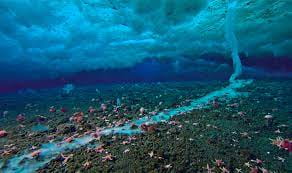Brinicles: The Icy Fingers of Death
On the 2011 British nature documentary series Frozen Planet, Alec Baldwin once described brinicles as “icy fingers of death” because of their deadly nature. Concretely speaking, brinicles are underwater stalactites, or hollow icicles, that form when cold saltwater freezes.
These underwater icicles are made possible by brine channels that form in the ice on the ocean’s surface. When sea ice forms in the Arctic and Antarctic, impurities like salt are forced out, which is why ice created from seawater isn’t as salty as the water from which it’s formed. As this salty water leaks from the sea ice, the surrounding water becomes more saline, increasing its density and lowering its freezing point temperature. This prevents the water from freezing to the ice and causes it to sink to the bottom. As this cold brine reaches warmer seawater below, the water freezes around it through heat transfer, creating a tubular-shaped ice known as a brinicle. When this sea stalactite reaches the seabed, a web of ice forms and spreads to its surroundings, freezing everything it touches — including any sea life it encounters, such as starfish and sea urchins — which is how brinicles earned themselves a reputation as “icy fingers of death.” Pools of super-cold brine may also form and remain beneath the site of brinicle formation. These so-called “black pools of death” can also be deadly to slow-moving, bottom-dwelling sea creatures that pass through them accidentally.
Fortunately, brinicles are not dangerous to humans, as we rarely travel beneath the ice sheets where they form. However, divers who study brinicles take precautions to avoid hypothermia or other cold water injuries.
Brine can be beneficial within the sea ice: it may warm and melt through the ice, moving heat from one part of the ice to the other. They also provide an ideal habitat for microscopic plants and animals, particularly diatoms (a type of algae) which sometimes stain the ice a dark brownish green.
If you thought underwater icicles were a surreal phenomenon, underwater lakes are even better. When the temperature of brine is not freezing, brine seeping into the ocean can form brine pools, with shorelines and all. Shockingly, brine lakes can range from 3 feet to 12 miles long in the Gulf of Mexico! These lakes are created by a process called salt tectonics, which refers to the movement of large salt deposits.
In 2011, the crew of Frozen Planet became the first to film a brinicle formation. They used time lapse photography to capture the event over the course of several hours. Their first attempt was unsuccessful, since large seals in the area knocked over their camera equipment and broke delicate, fledgling brinicle structures. See a short clip of their footage below.
Ripley’s Believe It or Not!, et al. “The Science of Brinicle: Ice Stalactites.” Ripley’s Believe It or Not!, 28 Apr. 2017, https://www.ripleys.com/weird-news/brinciles-ice-stalactite/.

Enjoy Reading This Article?
Here are some more articles you might like to read next: